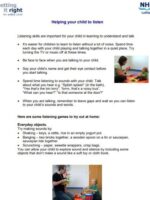
Listening skills are important for your child in learning to understand and talk.
- It’s easier for children to learn to listen without a lot of noise. Spend time each day with your child playing and talking together in a quiet place. Try turning the TV or music off at these times.
- Be face to face when you are talking to your child.
- Say your child’s name and get their eye contact before you start talking.
- Spend time listening to sounds with your child. Talk about what you hear e.g. “Splish splash” (in the bath), “Yes that’s the bin lorry”, “brrm, that’s a noisy bus”, “What can you hear?”, “Is that someone at the door?”
- When you are talking, remember to leave gaps and wait so you can listen to your child’s sounds and words.
Here are some listening games to try out at home:
Everyday objects
Try making sounds by:
- Shaking – keys, a rattle, rice in an empty yogurt pot.
- Banging – two bricks together, a wooden spoon on a tin or saucepan, saucepan lids together.
- Scrunching – paper, sweetie wrappers, crisp bags.
You can allow your child to explore sound and silence by including some objects that don’t make a sound like a soft toy or cloth book.
Who’s at the door?
Play a game with your child using something you have in the house such as a box, laundry basket, a tent or playhouse. Tell your child to listen for someone at the door. Make the sound of a doorbell or pretend to knock and encourage your child to ‘open the door’ when they hear the sound.
Ready, steady, go!
Build a brick tower together with your child. Your child waits and only knocks it down when you say “Ready, steady, go!”
Sit or stand opposite your child and roll a ball to them. Help your child to listen and roll the ball back to you when you say “Go!”
Listening to music
Listen and move to music together. Then switch it off a few times. When the music stops, sit down (musical bumps), or stand still (musical statues). To begin with, you might need to hold your child in your arms, or hold their hands, until they get the idea of the game.
What was that?
Play a game where you make the sound of one of your child’s toys or pictures. Make sure your child can see them. Use fun sounds e.g. meow, woof, brrm and nee-naw. Encourage your child to find
the toy and name it if they have the word. You can also play this game with outside sounds.
Promote listening through your daily activities:
- When you’re shopping ask your child to find things by giving them instructions e.g. “Can you get me the apples?”
- When you’re tidying up give your child an instruction like “Put the cars in the box.”
- When you’re doing your washing “Can you find daddy’s socks?”





